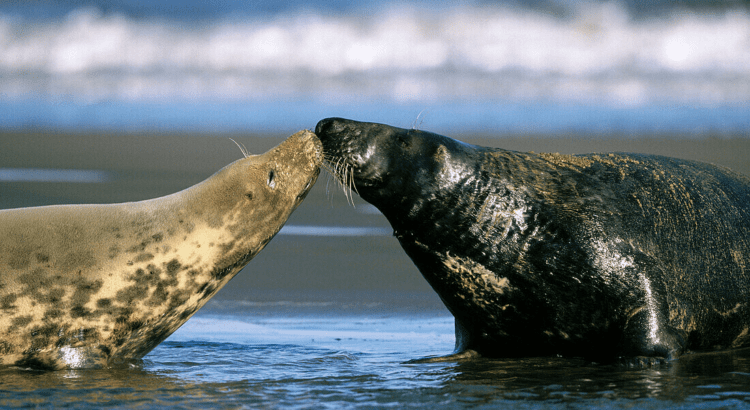Ellie Holter, SCA Interpretive Ranger
Halichoerus-grypus-prior-to-mating.
It’s safe to say that we all love wild animals, they are strong beautiful creatures and sometimes it feels like we just can’t get enough, but what is the best way to view these cool dudes? The truth is that when it comes to wildlife, the best type of relationship is a long-distance one! Now, I know what you’re thinking, long distances mean you may not get the very best view or a super close selfie and that might be a real bummer, but your safety and the safety of the animals you are viewing is WAAAYYY more important!
along-nhs-coast/.
Animals are generally not confrontational, but they deserve space and respect in their homes too! They can also be unpredictable, so it is always a good idea to back away (about 75 feet from most wildlife, and 150 feet from moose, bears, bobcats, and other large predators). To maintain this distance, you will also have to keep your pets on a leash so that they stay with you rather than getting closer to the wild animal. It doesn’t matter how well-trained your pet is, it can get hurt by a wild animal or become the reason a wild animal becomes injured!
One important note about keeping your distance from wildlife is that mothers and their young need extra space. You’ll want to give them extra space because mother animals tend to be very protective of their young ones and may be more likely to defend themselves than an animal without young. Sometimes human interference could even cause a mother to abandon her young. This could be because the parent was scared away, or their young was handled by a person and the mother then rejected the new scent on their baby.
In the unfortunate case that you do have a negative encounter with wildlife that results in one or both parties sustaining an injury, stay calm, then, when safe, notify park staff or animal control. If you are injured, seek medical assistance for yourself or, if applicable, your pet. Do not wait to do these things, wild animals, pets, and people can spread disease to each other which needs to be dealt with right away! Animal control also needs to know if there is an injured animal around or an abandoned baby.
buzz/five-incredible-things-know-about-chipmunks/.
Aside from giving wild animals their space, you should remember not to feed any critters while you recreate outside. Most human food is not good for wild animals because it is not a part of their normal diet. Additionally, creating a situation where an animal becomes accustomed to eating human food can be dangerous for both the animal and humans, as it makes them more likely to come into populated areas. Sometimes if an animal is visiting a campground or similar area often enough, it becomes a “problem animal” and may have to be euthanized. So what can you do to prevent this? ~ Don’t feed the wildlife! Stash your trash! And Store your food properly!
To stash your trash properly, use the trash can provided or pack your trash in a bear container.
As far as proper food storage is concerned, there are many different ways to properly store your food. The main idea is that you should keep your food in an area sealed from wildlife, but how you do this depends on where you are and what kind of wildlife lives there. For options, you can keep it in a bear box if available, tie your food up in a tree, use a bear canister, or store it in a sealed cooler in your vehicle…. No matter what you choose, you should remember that your food and sleeping space should be separate. DO NOT store food in your tent!
A few final notes:
Drive safe! Wildlife crosses and uses the roads we drive on too, so keep an eye out for them to reduce the chance of collision.
Remember the rule of thumb: When viewing wildlife, hold your arm out straight, and, if you can’t fully cover the animal in your line of sight with your thumb, you are too close!
Don’t forget that researching the wild animals that may be in the area you are going to is a good idea so that you are prepared to be safe around them!
I hope this post helps you enjoy the coolest critters in town safely!
Sources:
Centers for Disease Control and Prevention. “Wildlife.” CDC Healthy Pets, Healthy People. Accessed June 25, 2025. https://www.cdc.gov/healthy-pets/about/wildlife.html.
Leave No Trace Center for Outdoor Ethics. “Respect Wildlife.” Leave No Trace. Accessed June 25, 2025. https://lnt.org/why/7-principles/respect-wildlife/.
National Park Service. “7 Ways to Safely Watch Wildlife.” U.S. National Park Service. Accessed June 25, 2025. https://www.nps.gov/subjects/watchingwildlife/7ways.htm.
REI Staff. “Food Handling and Storage.” REI Expert Advice. Accessed June 25, 2025. https://www.rei.com/learn/expert-advice/food-handling-storage.html.

